Florence – map, sightseeing plan, attractions, accommodation, interesting facts
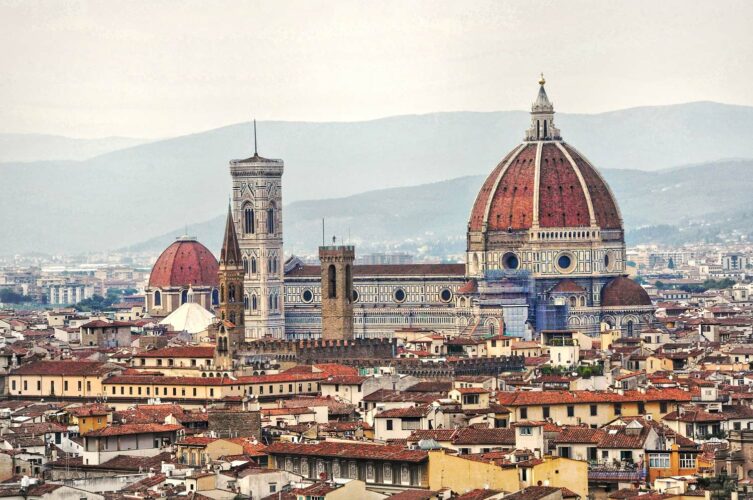
In the fumes of science and art
Many people have a big problem with Florence. Everyone knows that the city is beautiful, amazing, unique and filled with the atmosphere of the Renaissance. The Renaissance, which, according to popular opinion, appeared like a ray of light after the dark Middle Ages. The light that illuminated our minds, opening a new chapter in the history of humanity.
New concepts of philosophy, science and art were created, and in their wake, people created things that remain unmatched to this day (e.g. the dome of the cathedral in Florence is still the largest dome in the world, built of... bricks). It is enough to mention the names of a few selected Renaissance people closely associated with Florence: Leonardo da Vinci, Michelangelo Buonarroti, Giorgio Vasari, Niccolo Machiavelli and even the Medici family, which financially supported the development of science and art in Florence.
Ultimately, history recognized that the Renaissance that changed the world was born in Florence. The symbolic date of the birth of Renaissance art is marked by an unremarkable event related to the competition for the best design of the doors to the Florentine Baptistery (incidentally, it was the first artistic competition in the history of art). Seven works were submitted, but the competition was dominated by one extremely unusual and at the same time delightful idea, authored by Lorenzo Ghiberti. The project turned out to be so innovative and groundbreaking that it established a historical boundary between medieval and Renaissance art.
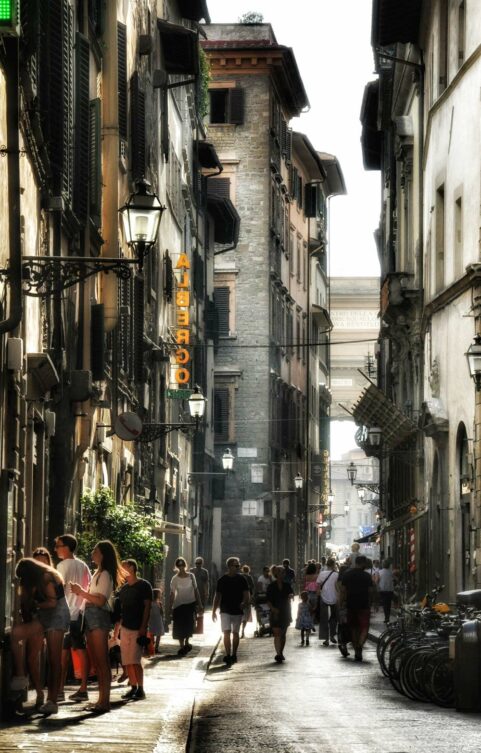
Hard landing
Walking the streets of the city, you get the impression that the Renaissance here is still going on and it is hard to imagine it ever stopping. It seems that in Florence you walk with your head in the clouds... until suddenly the earth knocks on your door, in the person of a street seller of cheap souvenirs, a con artist or, worse yet, a petty thief who will effectively empty your pockets while you are squeezing through the crowded streets.
Florence is a typical victim of its own attractiveness and popularity. The city attracts crowds of tourists, and tourists attract crowds of people who want to make quick and easy money. When I stopped for a moment on the main square in front of the cathedral to look at the scale of the crowd from a distance, I had the impression that the numbers of both groups were similar. Tourists and lovers of quick money, hunters and their victims, half and half! So we can safely say that in Florence there is a constant, Renaissance competition for the best way to quickly and effectively get money from a tourist. There is no escape from this. It is clear to anyone who has been to Florence that this city will rip you off. If you are prepared for it, the scale will simply be smaller, but either way, be prepared for the expenses.
My blunders
I bet that while reading the previous paragraph it occurred to you that since everyone in Florence has to overpay for something, it happened to me too. And what? Of course!
The first trap She already showed up in the parking lot. Back then, I wasn't that smart yet (maybe because there was no blog where someone would write about it) and I chose the wrong parking lot. I drove in more or less where I wanted, but not exactly where I needed to. It seemed to me then that there would be no big difference. A parking lot is a parking lot. There was a price list at the entrance, which I glanced at, but didn't look into. It looked like everywhere: division into several groups of vehicles depending on size, and corresponding prices. Higher than in other cities, but you know: Florence.
I found out the punishment after returning to the car. It turned out that the division into vehicle groups is different than one might expect and my small car (KIA Ceed) does not qualify in the small or even medium-sized group. However, it is included in the group of the largest limousines, in one row with the Mercedes S-class.
I ended up paying 80 EUR for 4 hours of parking.
Second mistake took place fifteen minutes after parking the car. It was hot, so we reacted instinctively when we saw ice cream being put into a cup with a small spatula. We immediately headed to the ice cream shop (it was near the Bridge of Vecchio). In the entrance doorway, we passed a German tourist, pale with impression, who was leaving the ice cream parlor with terrified eyes. She clutched the receipt in one hand and a cup of ice in the other. At the same time, she was mumbling something unintelligible under her breath, looking alternately at the ice cream and at the receipt. This did not increase our vigilance.
We went inside. On the wall above the counter behind the salesman was a list of flavors in several languages, with no prices. This did not increase our vigilance either.
The seller gave us the flavors we chose and then handed us a piece of paper with which he told us to go to the cash register. From the moment I heard the price of the ice cream at the cash register, I don't remember what happened. I think I passed out. My family claims that I was stable on my feet, but I left the ice cream parlor in a similar condition to that of the German tourist I had passed earlier.
Bill for four ice creams (4 x 1 scoop): 56 EUR
Third situation it was an ordinary street act. There is always a large crowd in front of the cathedral in Florence. The entire area of the square is occupied alternately by tourists and traders. There is no division here into a zone for traders and a zone for tourists. Traders place their goods right on the pavement, often in the middle of the square, so when admiring the cathedral with your head up high, you have to be really careful not to step on anything. It would never have occurred to me that traders would want something completely different! Everyone knows that most tourists don't buy tacky gifts in Florence. So how do you get someone like this to buy something anyway? Just make him destroy something at the stall and have to pay for it. Easy?
This is what happened in my case. I was walking slowly, with my head tilted upwards, when suddenly someone bumped into me. This caused me to lose my balance and stumble two steps to the side. In the second step, just before regaining my balance, I placed my foot... on Mona Lisa's face. Here, on the pavement, there were prints of various works by Leonardo da Vinci (from an inkjet printer on drawing paper), which were sold as souvenirs from Florence. Of course, even the dog with the lame leg wasn't interested in them.
The seller picked up a portrait of Mona Lisa from the pavement with the tread of my shoe tastefully imprinted on its face and demanded compensation in the amount of EUR 200. The negotiations took a long time. The seller was supported by his colleagues from neighboring stalls, standing behind me, which was supposed to increase the pressure. I finally paid 50 EUR (for something that was worth maybe 2 EUR) and the portrait of "Mona Lisa with a table runner" became my property.
After some time, when we were crossing the square again, the man who had bumped into me earlier and made me lose my balance was standing at a stall as a seller.
Why am I writing this?
Florence is a fantastic and captivating city. I can't imagine visiting Tuscany without a solid visit to Florence. However, you need to be prepared for these visits in order to get the most pleasure from them. If you are prepared for the street phenomena that take place here, you will have a lot of great experiences in Florence. If you come here without this awareness, you may become a victim of local tricksters and it may spoil your mood, stay and memories. It would be a pity if this wonderful city, offering so many fantastic experiences, had bad associations due to mistakes that could be avoided.
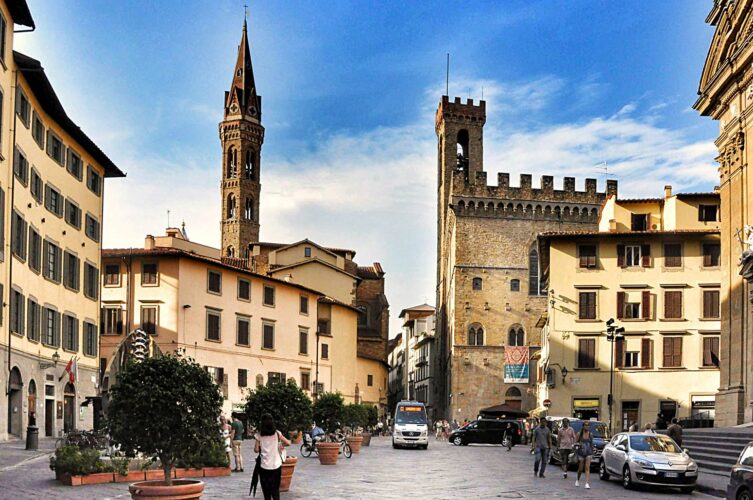
Florence is a good start
For most tourists, Florence is not the only destination in Tuscany. It is often a starting point (due to the proximity of several airports) and a starting point for exploring the entire region. A complete itinerary for visiting Tuscany with maps can be found in the entry: Tuscany – sightseeing plan and map – [click]
If you get here by plane, you can continue your sightseeing by public transport or a rented car. Some people decide not to rent a car from a rental company because they have no experience in this matter. Many people also fear that renting a car is more expensive than traveling by train or bus. A lot has changed in this matter in recent years and renting a car has become much easier, safer and cheaper. Nowadays, you can often find cheap and safe rental offers (with full car insurance against damage), you just need to know where and how to look. I have written a separate guide on this topic, which explains in a simple way things that may seem difficult at first glance. It also provides a specific, step-by-step recipe for renting a car without a credit card and without a deposit. Read: Italy – car rental without deposit and credit card [GUIDE]
If the guide itself is not enough, you can also read my report on renting a car in Italy, along with copies of documents from the booking process and from the rental company itself: Bari – car rental – [click]
Where is Florence?
Florence is located in central Italy, at the foot of the Apennine Mountains, and is the capital Tuscany.
Florence's favorable location is best seen on the map below. From the city it is easy to get to the north of Italy and you can basically get everywhere in one day. If you direct your steps south, you will quickly reach Rome, and then Naples and continue towards Apulia and other regions.
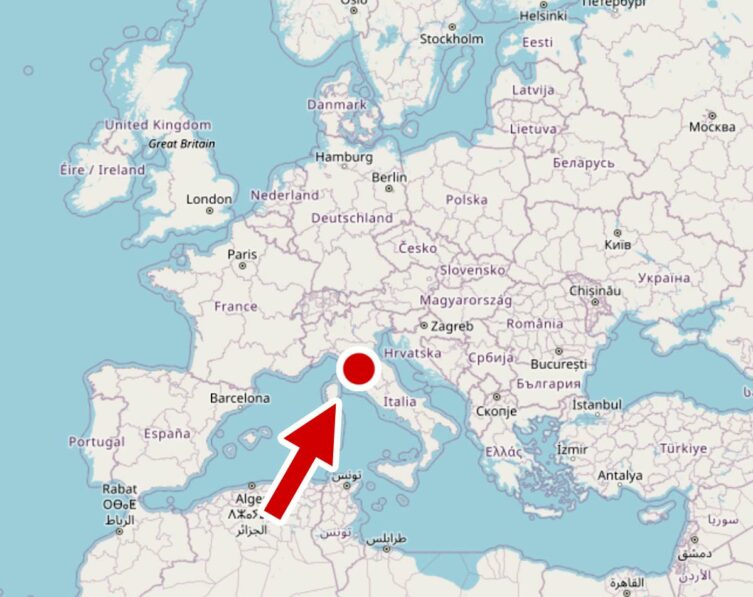
Florence sightseeing plan
At the beginning of planning there is always a problem of where to start. This time we will start with some important information that you will need before you even start planning. In the case of Florence, this is quite important because we are dealing with restrictions that the city deliberately introduces to relieve the city center. This results in a very high interest in attractions, which results in limited availability of tickets (usually there are much fewer tickets than there are people interested).
Florence ZTL - Limited Parking Area
In Florence, there is an extensive Restricted Car Traffic Zone, marked as ZTL (Limited traffic zone). Car traffic within this zone is severely limited and, in short, tourists are not allowed to enter here. The exception is driving to the hotel, as long as your hotel is located in the ZTL zone. In such a situation, you must contact the hotel in advance to determine how you should behave when entering the ZTL zone.
Cars unauthorized to enter the ZTL zone are also prohibited from parking in parking lots located within the ZTL area, even if there are free spaces. You just shouldn't be here!
Unauthorized entry into the ZTL area results in a high fine. There's no need to get caught. The area is monitored and the monitoring is regularly analyzed, so I do not recommend any combinations.
Accidental entry into the ZTL area is practically impossible, because each entrance is clearly marked with boards and traffic lights (I don't expect anyone to drive through a red light without reading the board).
Of course, there are narrow time intervals during which entry to the zone is open. This mainly applies to night hours and selected days of the week, and the rules are not easy to remember. The entire ZTL zone in Florence is divided into five subzones (marked with the letters A, B, O, F and G), and each subzone has slightly different rules. In my opinion, going through these rules just to park 300 meters closer makes absolutely no sense. Moreover, when entry to the ZTL zone is possible without restrictions, the traffic lights change from red to green and this explains the problem of being able to enter the ZTL area.
However, if anyone needs to verify the current rules for entering the ZTL zone, I am posting detailed ones map of the ZTL zone in Florence – [click] and a link to the current ones rules and hour ranges of the ZTL zone – [click].
I do not include the above data directly in this entry because they change from time to time and I would not like to mislead anyone. It is better to use current source data.
For our needs, I have prepared a special, slightly simplified map of the ZTL zone. I removed the unnecessary division into five subzones and I have marked several large and conveniently located parking lots located on the border of the ZTL zone. You can get to them without fear of violating the border of the ZTL zone and they are close to the attractions we are interested in. Additionally, I added a map of attractions and the approximate sightseeing route to the map of the zone and parking lots. In this way, a map was created containing all the information necessary to conveniently plan arrival, parking and sightseeing in Florence.
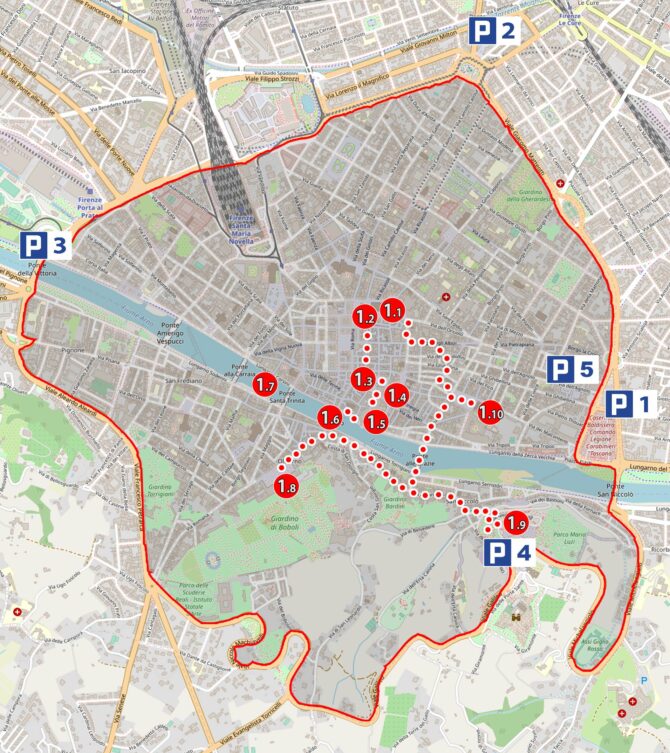
Below are the coordinates of the parking lots marked on the map. Parking lots available to all tourists because they are located outside the ZTL zone. I think this will make your life much easier.
P1 – Underground parking lot: Parcheggio Beccaria, GPS coordinates:
43°46’10.7″N 11°16’15.3″E
43.769627, 11.270909 - click and route
P2 – Multi-story parking lot: Firenze Parcheggi – Parterre, GPS coordinates:
43°47’07.9″N 11°15’44.7″E
43.785527, 11.262414 - click and route
P3 – Outdoor parking: Parcheggio Vittorio Veneto, GPS coordinates:
43°46’31.7″N 11°14’09.8″E
43.775473, 11.236048 - click and route
P4 – parking lot at the Florence viewpoint: Parcheggio Viale Michelangiolo, GPS coordinates:
43°45’45.6″N 11°15’53.0″E
43.762671, 11.264726 - click and route
P5 – underground parking lot: Parcheggio Stazione Fortezza Fiera, GPS coordinates:
43°46’57.6″N 11°14’44.9″E
43.782656, 11.245808 - click and route
P6 – underground parking lot: Parcheggio Sant'Ambrogio Firenze, GPS coordinates:
43°46’12.9″N 11°16’06.7″E
43.770246, 11.268524 - click and route
the street leading to this parking lot does not belong to the ZTL, but everything beyond the access street is already a ZTL zone
Tickets to attractions
Tickets to attractions are always the weakest point of any plan. Just imagine that you are at your destination and there is a queue at the checkout window for an hour (or more). You think, OK, I'll wait. I'll manage somehow. After an hour, you are at the ticket window and ask for a ticket, and the lady at the window says that the next free entry to the attraction is in two hours... What do you do?
Are you buying a ticket and waiting for the next two hours wasting your whole day? On this day, you will definitely not have time to see everything you wanted.
Or maybe you give up on entering the attraction you really wanted and for which you traveled thousands of kilometers? Just thinking about it makes me sick. Especially since I found myself in exactly this situation several times.
There is at least one place in Florence where there are huge queues most of the year and it is simply impossible to buy a ticket without advance notice. It is the Uffizi Gallery, one of the most important and beautiful museums in the world. During the season, several other places can be added to the list of attractions with difficult access due to crowds. But can something be done about it?
Nowadays, the problem can be easily solved. How?
Many facilities allow you to purchase tickets in advance online. If there is such an opportunity, I always use it. I buy a ticket for a specific day, and if it is necessary to choose an entry time, I choose the one that is most convenient for me and fits my plan. On the day of the visit, I skip the entire queue and enter with a previously purchased ticket. Usually, there are even separate entrances without queuing for holders of such previously purchased tickets.
In this sightseeing plan, next to the attractions' descriptions, I will include links to the sale of admission tickets via the Internet. It is not possible everywhere and it is not necessary everywhere, but where it can be done you will find the appropriate link.
Ticket packages – an interesting option
Ticket packages seem to be an interesting option. You buy tickets to several attractions at once. You can often find promotions and the price you pay for the package may be cheaper than the sum of the individual tickets.
At the time of writing this text, the following packages seem to be an interesting proposition:
Tickets Passepartout 5 Days – [click], which includes:
– skip-the-line entry to the Uffizi Gallery
– skip-the-line entry to Palazzo Pitti
– free entry to the Boboli Gardens
– free entry to the National Archaeological Museum
– skip-the-line entry to the Museo Opificio delle Pietre Dure
Florence Pass – [click], which includes:
– entry to Brunelleschi's Dome
– entry to Giotto's Belfry (valid for 72 hours)
– entry to the Opera del Duomo Museum (valid for 72 hours)
– entry to Santa Reparata (valid for 72 hours)
– free entry to the cathedral in Florence
– skip-the-line entry to the Uffizi Gallery
– skip-the-line entry to the Academy Gallery
– admission to the room with the sculpture of Michelangelo's David and to all exhibitions of the Academy Gallery
– digital audio guide to the Academy Gallery
– audio guide application with over 70 attractions in Florence, visualizations, descriptions and audio comments from local experts, interactive digital maps and navigation (no Polish language available)
You may be more interested in a different ticket package. You can check the available options at this link: Florence all city cards and ticket packages – [click]
Use GPS coordinates
I provide precise GPS coordinates for each attraction. This may not seem particularly useful at first glance, but in practice, the exact opposite is true. Thanks to these coordinates, you do not have to stick to a specific sightseeing path. You can explore the city basically as you like.
How to use GPS coordinates in practice? Just click on the link next to them. Then the navigation will open on your phone and automatically calculate the path to your destination, but… you don't have to follow this path! Walk as you like, wherever you want and treat the indication on the phone only as an indication of whether you are approaching your destination or whether you have already taken the wrong direction. Visiting the city is not about walking the shortest route, but enjoying its atmosphere. Thanks to GPS coordinates, you don't have to worry about getting lost, and at the same time you have unlimited freedom of sightseeing.
In short: click on the coordinates, walk and check from time to time to see if you are going in the right direction. No nerves, no stress, pleasure. Simple and beautiful!
Florence – map of tourist attractions
We have already completed important organizational issues and the initial topography of the city. So it's time to go through the attraction maps. You already have an approximate idea of how the main attractions of Florence are located in relation to each other. They were located on the previous map of the ZTL and parking zones. Here I will post an additional map, limited only to the area where the attractions we are interested in are located. Narrowing the map area makes it more precise.
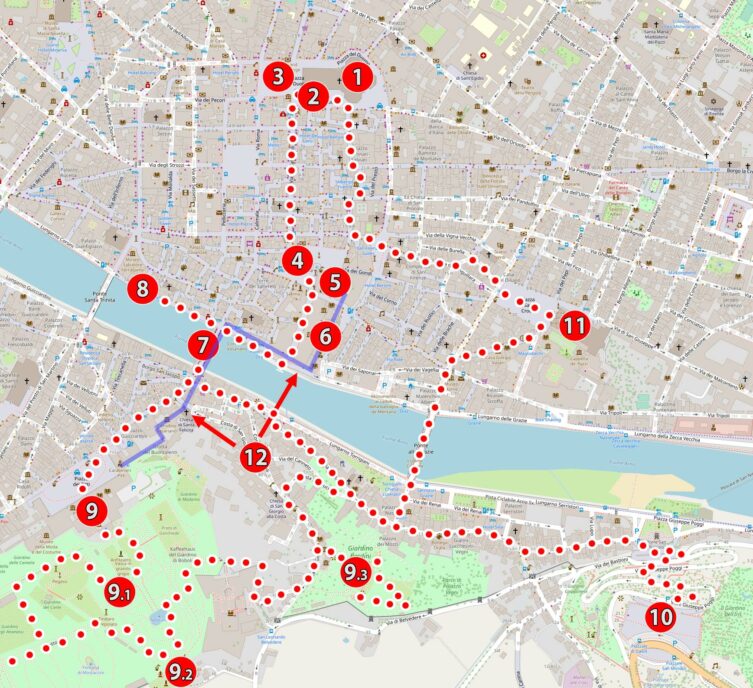
Florence – sightseeing plan
From this moment on, planning your visit becomes very easy. Depending on where you are at the beginning of the tour (one of the parking lots or the railway station), you can start your tour from any attraction. The entire route is a closed loop, so regardless of where you start, you will return to the starting point at the end of the trip. Using GPS coordinates and navigation on your phone, you can explore Florence without restrictions, changing the direction and even the order and number of attractions.
For people who have less strength or will simply be in weaker shape that day, or the sun will make you lose the desire to carry out an intensive plan, it is possible to shorten the route. After number (9) - Palazzo Pitti, you can go straight to number (10) - Michelangelo's Square, skipping numbers (9.1) - Boboli Garden, (9.2) - Porcelain Museum, (9.3) - Bardinia Garden and Villa.
That's how I came up with it. Thanks to this, the plan becomes universal, can be used in many different ways and adapted to the available time, strength and willingness.
Have fun exploring!
Detailed descriptions of attractions in Florence
1. Cathedral of Santa Maria del Fiore (Cattedrale di Santa Maria del Fiore)
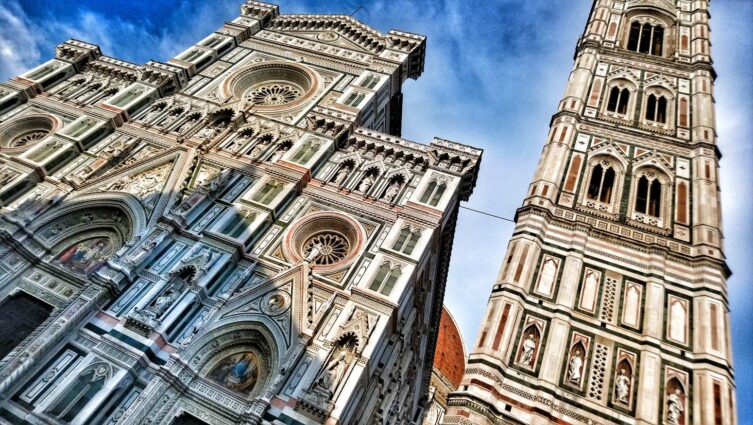
Only by standing face to face with the cathedral in Florence will you gain a real idea of the size and power of this building. No photos, even the most suggestive ones, can convey the enormity and intricacy of this structure. Well, the fourth largest cathedral in the world must be impressive. Only three cathedrals are larger than it: St. Peter in Rome, Cathedral of St. Paul in London and the Duomo in Milan. Anyone who has seen at least one of these three cathedrals before and is now standing in front of the one in Florence will think that something is wrong here. The building in Florence seems a bit bigger. Why?
Note that there is usually a lot of space in front of other massive cathedrals. There is a square, there is space, there is a lot of air. The cathedral in Florence is sandwiched between other city buildings and its shape fills almost the entire square. The place where she stands was not intended for her. Previously, there was a much smaller church here (Santa Reparata), and the cathedral was built in its place, making more use of the space recovered from the church. The currently quite impressive buildings next to it look like miniatures. This relationship between adjacent buildings additionally emphasizes the size of the cathedral, and we gain a proportion that makes us realize how powerful this building is.
Add to this the fact that the world's largest brick dome (designed by Filippo Brunelleschi) towers over the fourth cathedral in the world. It is a construction whose implementation was widely considered impossible, and only Filippo Brunelleschi himself believed in its successful implementation (although periodically he began to doubt it) and the Medicis, who wanted to achieve something unattainable. And it must be admitted that they succeeded. Almost 600 years have passed, and the dome of the Florence Cathedral is still the greatest human construction achievement of this type.
The construction of the cathedral took 140 years (first works: 1296, consecration: 1436), but the actual history of its construction is much longer and more interesting. Apart from the countless adventures associated with overcoming the impossible, i.e. the construction of the dome, an interesting story is also associated with the colorful facade. The original design by Arnofla di Cambio was only half completed and then demolished in 1578. Why? I don't know, but the rest of the story is even more interesting. A new competition for the facade design was announced. It has not been resolved because all projects were rejected. What was there to do? Another competition had to be announced. Unfortunately, the effect was the same: all projects were rejected. Further competitions were announced and projects rejected for the next… 300 years!!! The solution came only in 1871, thanks to the design of Emilio de Fabris. The work was completed six years later. The facade is covered with a three-color mosaic made of three types of marble:
– white marble – imported from Carrara
– green marble – imported from Prato
– pink marble – imported from Maremma
If the construction time of the cathedral were to also take into account the construction time of the façade, it can be safely said that Santa Maria del Fiore was built for 600 years.
Curiosity:
During renovation works in the basement of the Cathedral of Santa Maria del Fiore, the remains of the structure of the previously standing church of Santa Reparata were discovered. Some time ago the find was made available to visitors.
Tickets
Entrance to the Cathedral of Santa Maria del Fiore is free. There is often a long queue in front of the entrance, but don't be afraid of it as it moves quite quickly. For some time, a solution involving the mandatory and paid (EUR 2,5) download of an audio guide was tested at the entrance to the cathedral. This was to reduce the noise generated by tourists inside the cathedral and thus allow more visitors to be admitted at one time (tourists with audio guides generate much less noise). I don't know if this solution still works, or maybe it has been replaced by another idea.
You have to pay for admission:
– to the dome (Cupola di Brunelleschi),
– to the basement of the cathedral (Santa Reparata)
– to the cathedral museum (Museo dell'Opera del Duomo)
– to Giotto's bell tower (Campanile di Giotto)
– to the Baptistery of San Giovanni (Battistero di San Giovanni)
Tickets can be purchased in the form of a ticket package, in various configurations. I will not point out one best package, because everyone is interested in a different set of attractions. Here is a link where you will find some suggestions.
Check it out: ticket packages for attractions at the Cathedral in Florence – [click]
WARNING!
In ticket packages, pay attention to the similarity of words Duomo i Dome. Duomo means Cathedral, and Dome is short for Dome Brunelleschi, i.e. the dome of the cathedral. Purchasing a ticket that includes entry to the Duomo is not the same as entry to the Dome.
This is a common mistake made by tourists who buy a ticket that mentions entry to the Duomo (free), confusing it with entry to the Dome.
Cathedral of Santa Maria del Fiore, GPS coordinates:
43°46’23.4″N 11°15’20.2″E
43.773173, 11.255613 - click and route
2. Giotto's Bell Tower (Campanile di Giotto)
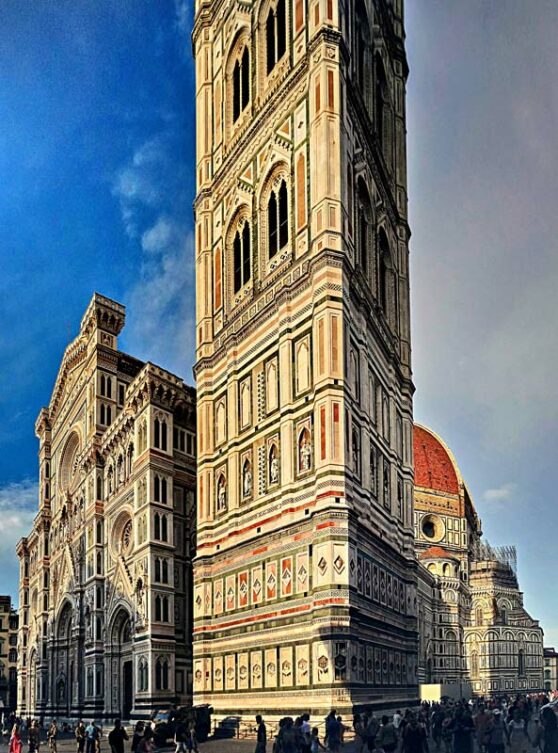
Slender, beautiful and tall (85 m). This is Giotto's bell tower, which, as the name suggests, was designed by Angiolo di Bondone, called Giootto for short from the diminutive of his name (Angiolotto). Unfortunately, Giotto did not live to see the construction completed. After him, the work was carried out by two more architects, and the construction was completed by Francisco Talenti, who at the same time added a window of his own design on the top floor to the bell tower.
There are seven bells in the bell tower. The largest "Campanone" weighs 5300 kg, is 2 meters in diameter, 2,1 meters high, was built in 1705 and it's better not to hear it when you visit the observation deck, because it can probably be heard throughout Tuscany.
There are 414 steps leading to the observation deck and to get to the top you have to climb them all :) on your own feet. There is no elevator or other facilities.
Tickets: available separately – [click] or more profitable within ticket package – [click]
Giotto's bell tower, GPS coordinates:
43°46’22.2″N 11°15’20.5″E
43.772843, 11.255706 - click and route
3. Baptistery of San Giovanni (Battistero di San Giovanni)
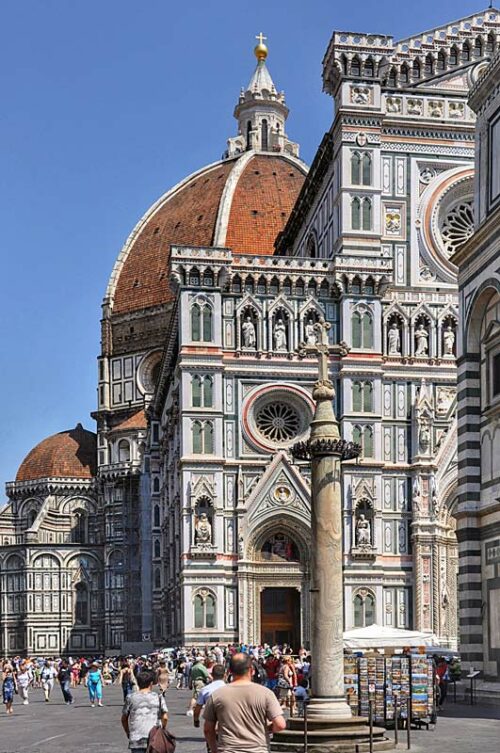
Compared to the nearby cathedral and Giotto's bell tower, the Baptistery of San Giovanni is tiny. A little thing that seems like a minor addition. In fact, of the buildings on the finger, the baptistery is the oldest and stood here before all the other buildings appeared.
An epochal change is directly related to the Florentine baptistery, because in one of the walls of this building (the northern one) there is a door designed by Lorenzo Ghiberti, from which the beginning of the Renaissance era is conventionally dated.
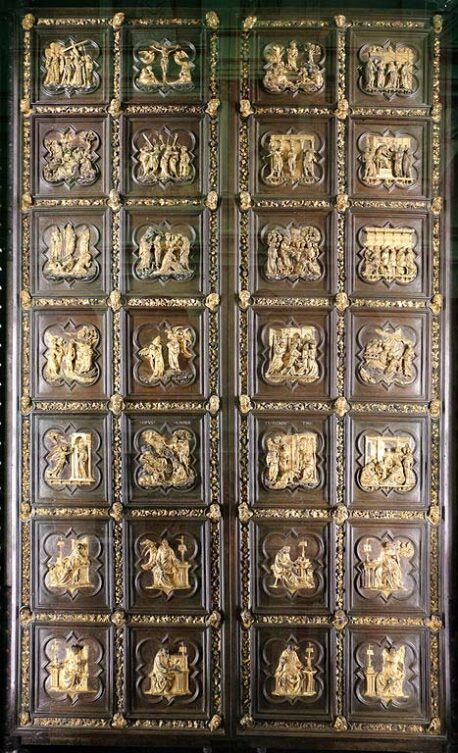
photo: Sailko on principles CC BY-SA 3.0
Another world-famous door (by the same designer), which Michelangelo called the Door of Paradise, is installed in another wall (eastern) of the baptistery.
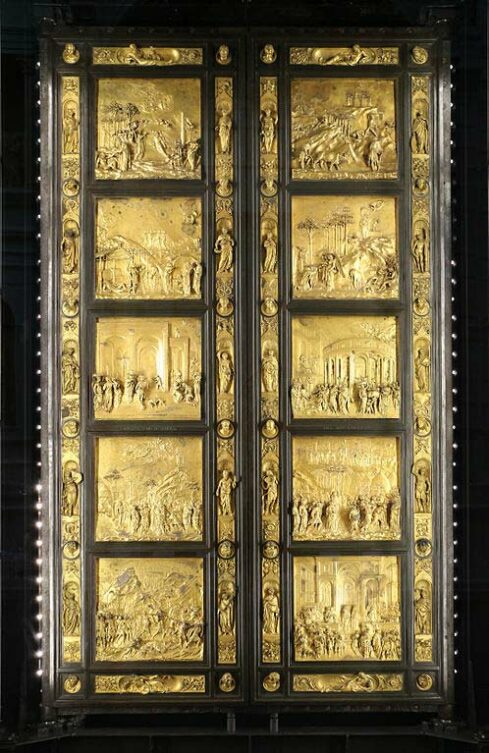
photo: Sailko on principles CC BY-SA 3.0
The last, third door by Andrea Pisano takes place in the southern wall. Originally, they served as the main doors of the baptistery (in the eastern wall), but were replaced by the Doors of Paradise.
When visiting the baptistery, it is worth paying attention to the huge zodiacal clock in the form of a mosaic on the floor. It is highly probable (until a lantern was added to the top of the building in the XNUMXth century that covered the entrance hole) that the mosaic served as an active astronomical clock. On the day of the summer solstice near noon, a ray of sunlight entered through an opening in the top of the dome and illuminated the floor in the center of the marble zodiac for a few minutes. An almost identical zodiac clock, still in use today, is located in the Basilica of San Miniato al Monte, also in Florence.
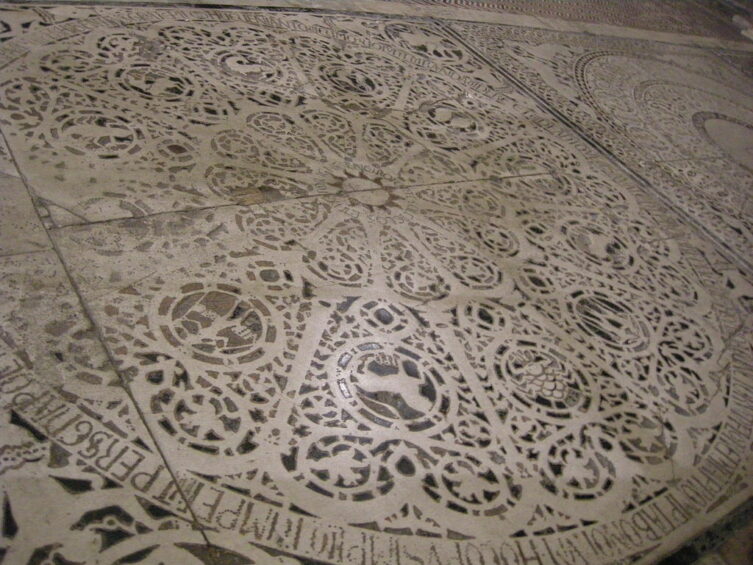
photo: Sailko on principles CC BY-SA 3.0
It is worth adding that for centuries the Battistero di San Giovanni was the main baptistery of Florence and most of the famous Florentine figures were baptized there, including Dante Alighieri and the lion's share of the Medici family. Nowadays, baptisms still take place here every Saturday.
An inconspicuous building with a great history!
Baptistery tickets:
- small package [click]
- big package [click]
Baptistery of San Giovanni, GPS coordinates:
43°46’23.4″N 11°15’18.3″E
43.773173, 11.255089 - click and route
4. Signoria Square (Piazza della Signoria)
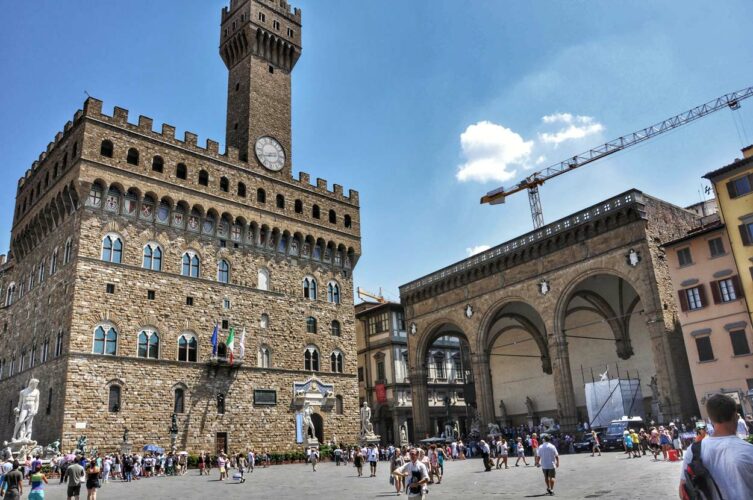
The most important square in Florence was built quite late, and its location can hardly be considered accidental. There is a very interesting story associated with it.
In order to avoid going too deep and not necessarily necessary into dates and facts, I will only mention that in the turbulent XNUMXth century, two main factions competed for power in the city: supporters of the Pope (Guelphs) and supporters of the Holy Roman Empire (Ghibellines).
The Guelphs came mainly from the social group of merchants and traders, and the Ghibellines from the magnates. As you can easily guess, the Medici merchant family sided with the Guelphs.
The struggle for influence was long (it was fought by several generations of Medici), and the advantage and power changed hands many times. The final decision came in 1289, when the Guelphs defeated the Ghibellines in a battle near Arezzo (Campaldino, to be precise). An interesting fact is that the young poet Dante Alighieri (he was 24 years old) took part in this battle. More than 1700 Ghibellines lost their lives, and over 2000 of them were taken prisoner. As Dante later recalled, the leader of the Ghibellines, who was shot in the throat during the battle, fell into the river and thus ended his life.
Four years later, the new authorities of Florence issued the so-called Regulations of Justice, depriving magnates of the right to exercise power indefinitely. From now on, power in Florence was reserved exclusively for members of the city's trade guilds. A new, second Republic of Florence was born.
What does this have to do with the square? Well, in the place where today there is a permanent square, there were Ghibelline houses. By decision of the Florence authorities in 1298, the houses of the Ghibelline families were demolished and in their place a square and a new seat of the city authorities were built: the town hall with a huge bell tower. In these circumstances, the creation of the square and the town hall is difficult to understand other than as an eternal symbol of the triumph of the Guelphs (merchants led by the Medici) over the Ghibellines (magnates).
However, the symbolism of the square goes even deeper! Just look under your feet while walking along it. While implementing the project to build the square and the town hall, the inhabitants of Florence came up with another idea. They decided to dismantle the palaces belonging to the Ghibelline magnates and cover the entire square with the stones recovered from them. Magnacija's wealth was reduced to the role of paving stones.
While walking around the square, you will come across several interesting objects that cannot be missed:
– Neptune's fountain with a white marble sculpture of Neptune
– sculpture of David by Michelangelo (unfortunately, there is a copy in the square, and the original was moved and is exhibited in the Galleria dell'Accademia museum
– the Herkules i Kakus group (right next to Dawid) by Baccio Bandinelli
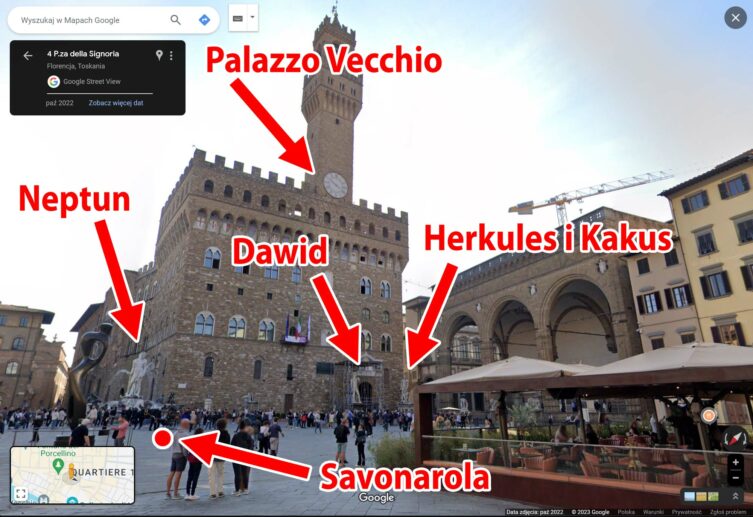
While observing the pavement in Piazza della Signoria, you may come across a small, round commemorative plaque (near the Neptune Fountain). The plaque is not very noticeable, but is a souvenir of unusual events related to the activities of the influential Dominican Girolamo Savonarola. Thanks to his efforts, the "bonfire of vanity" was ignited in this exact place on February 7, 1497. In practice, it was a huge, multi-level pile made of things taken from the inhabitants of Florence. The items collected were the so-called “signs of vanity”, i.e. entities indicating excessive luxury and wealth. As you can easily guess, extremely valuable items ended up on the stake, including recognized works of art (it is known for certain that several of Botticelli's works were burned here). The collection of "vanity tokens" lasted in the city for a month, and some historians claim that the "Soldiers of God" who conducted it made a lot of money, because apparently not everything ended up in the pile :)
As befits the cradle of trade, there was also a Florentine merchant who offered to buy a pile of "vanity tokens" for twenty thousand guilders. In return, he guaranteed the permanent liberation of the city from all the "signs of vanity" gathered in the pile. It would probably be his deal of a lifetime.
The history of this place is completed several weeks later. Fortune turned away from Savonarola, and with it Florence. He was found a heretic in a church trial and then sentenced to death. Girolamo Savonarola was first hanged, and his dead body was burned at the stake in exactly the same place where the "bonfire of vanity" had burned recently. The Dominican's ashes were thrown into the Arno River so that no relic would remain of him. Over the next 250 years, the Savonarola trial saw the so-called an intolerable error, and Pope Benedict XIV included him in the index of "blessed servants of God and venerable men and eminent saints."
Signoria Square, GPS coordinates:
43°46’11.2″N 11°15’20.0″E
43.769763, 11.255563 - click and route
5. Palazzo Vecchio (Palazzo Vecchio)
Interior of Palazzo Vecchio:
The role that Palazzo Vecchio was to play in the city was clear from the beginning: it was to be the main seat and the central center of power. It happened! The houses of the defeated Ghibellines were demolished and in their place a town hall was built, symbolizing the basic principles upheld by the victorious Guelphs. The simple and austere shape of the town hall reflected and still reflects the values of the new government: moderation and economy.
The system of governance adopted by Florence was downright revolutionary at that time. In Europe, there were feudal monarchies with power transferred on the basis of inheritance, and in Florence something like random elections began to be organized!
The system was quite interesting, because elections were held every two months (!!!), and everything took place in public, on Signoria Square in front of the town hall.
Candidates for seats on the city council could nominate themselves. All members of guilds and guilds (merchants, factory owners, bankers, but also craftsmen, shopkeepers and artists) had the right to register, but only after reaching the age of thirty. Bankrupts, people in arrears with taxes and aristocrats did not have the right to submit their candidacies.
A few days before the end of the current term, the inhabitants of Florence gathered in the square in front of the city hall. After traditional speeches and ceremonies, eight names were drawn from sealed leather bags (among all registered people): council members (priori) and the standard-bearer (gonfalonier) at their head.
Thanks to these elections, the Florentines gathered in the square had a strong sense of participation and influence on the functioning of their city. Many of them, thanks to the luck of the draw, could have been elected to the Signoria (i.e. the City Council) at any time.
Palazzo Vecchio is still the seat of the city government.
The 94-meter-high tower with an observation deck and the Vecchio Palace are open to tourists, and admission is charged.
Learn More: entrance tickets to Palazzo Vecchio – [click]
Vecchio Palace, GPS coordinates:
43°46’09.3″N 11°15’21.6″E
43.769238, 11.255995 - click and route
6. Uffizi Gallery (Galleria degli Uffizi)
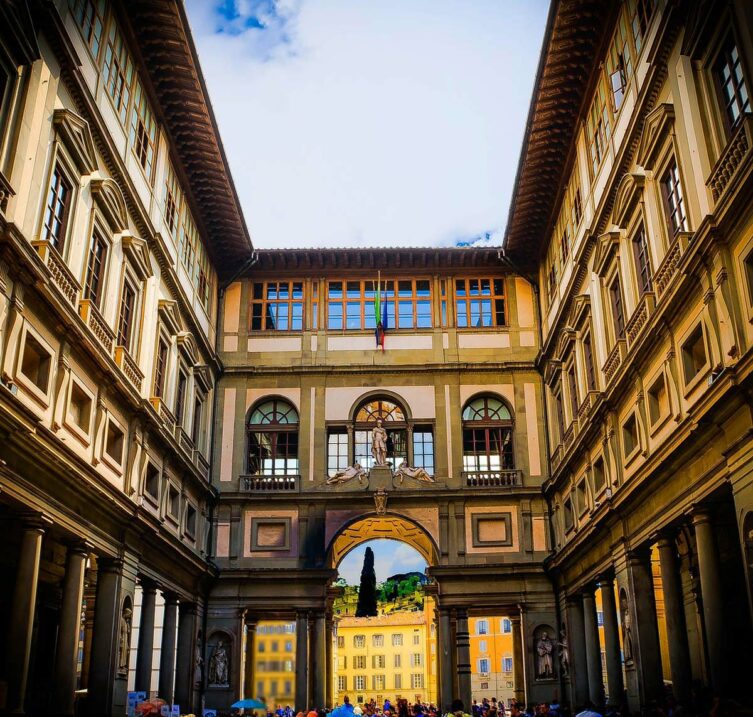
Uffizi in Italian means: offices. This says a lot about the building's original purpose. Florentine administrative institutions and courts were supposed to function here.
The originator of the project was Cosimo I de' Medici and the main architect was Giorgio Vasari. Unfortunately, both of them died before the construction was completed, and the project was carried out by Cosimo's son, Francesco I de Medici, and Bernardo Buontalenti.
On the orders of Francesco I de Medici, the top floor of the building was immediately designated as an art gallery for the collections gathered by the Medici, and over time, works of art began to occupy other rooms and floors of the building.
Currently, the Uffizi Gallery is one of the most famous and important museums in the world. The greatest works of art are exhibited in extraordinary interiors, by artists probably known to everyone: Giotto, Sandro Botticelli, Leonardo da Vinci, Michelangelo, Raphael, Albrecht Dürer, Titian, Rubens, Antoon van Dyck, Rembrandt, Caravaggio ... and all this under one roof, in one place. I really recommend it, it's really worth it (although it's not cheap).
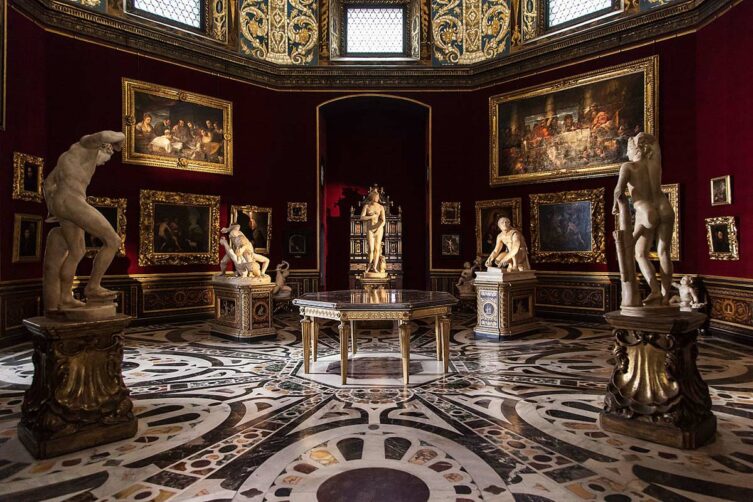
photo: Marta De Bortoli1991 on terms CC BY-SA 4.0
Unfortunately, the quality of the exhibition and the popularity of the museum make it very difficult to get to. You can't even dream about buying tickets on the spot. This has to be dealt with in advance and it is worth doing much earlier. If you are unable to buy a regular entry ticket, you can look for the opportunity to join an organized group with a guide. Such tickets are a bit more expensive (including the price of the guide's service), but sometimes there is simply no other option.
Below are links to two ticket distributors. You will find various options here, at various prices. Availability changes quickly, so I will not recommend one selected source, because it may turn out to be sold out and unavailable at the moment.
Just browse the options and choose the version that is best for you. Among these proposals you will also find the so-called passes, containing ticket packages to several attractions at once (sometimes it is worth it, due to the price).
check out:
– Tiquets: tickets to the Uffizi Gallery – [click]
– GYG: tickets to the Uffizi Gallery – [click]
Uffizi Gallery, GPS coordinates:
43°46’06.7″N 11°15’21.0″E
43.768540, 11.255827 - click and route
7. Bridge of Vecchio (Ponte Vecchio)
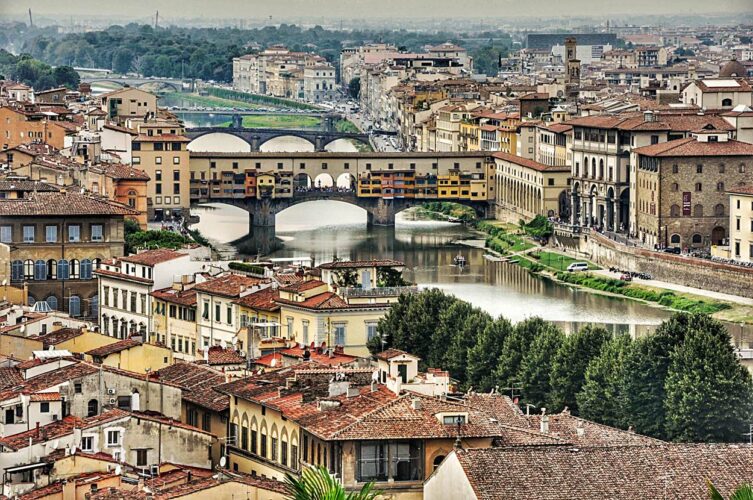
If it weren't for a few events, the bridge would have a completely different name today. It would most likely be called: Butcher's Bridge. The story is short but very interesting.
The structure we know today is the fourth bridge to stand in this place. The first one (dating back to the times of ancient Rome) was wooden and over time was replaced by a newer and better structure. Unfortunately, two floods (in the 1345th and XNUMXth centuries) destroyed the bridge twice. The current (fourth) stone structure was built in XNUMX and fortunately is still standing well.
The bridge has always been a great place for trade, so shops immediately began to appear there. At first, they were mainly meat and fish shops, and then they were joined by tannery workshops. I imagine that this set of goods and services generated such a stench that you could find your way to the bridge with your eyes closed, guided by the smell.
Then came the changes. They began thanks to Cosimo I de' Medici, who came up with the idea of building a safe passage connecting the main seat of power (Palazzo Vecchio) with the living quarters located on the other side of the Arno River, which was the Pitti Palace. The order to develop the project was, of course, given to the Medici's favorite architect, Giorgio Vasari. A plan was quickly developed to build a 1 km long, isolated corridor that runs across the roofs and facades of other buildings, including the roofs of the shops on the Bridge of Vecchio.
It can be safely assumed that the Medici were happy to use the discreet passage because the stench of meat, fish and tannery workshops began to disturb them. It is true that Cosimo I did not take any action in this matter, but his son Ferdinand I de' Medici categorically decided (1593) that the activities previously carried out on the bridge were to be replaced by goldsmith workshops.
Today the bridge smells only of gold and this smell doesn't bother anyone. So we have the Bridge of the Vecchio, although, as I mentioned at the beginning, the history and the name associated with it could have turned out completely differently.
WARNING!
Admission to the bridge and crossing it is free, but stopping at one of the exhibitions may lead to complete ruin of your wallet and household budget :)
Ponte Vecchio, GPS coordinates:
43°46’04.6″N 11°15’11.2″E
43.767948, 11.253112 - click and route
8. Arno River
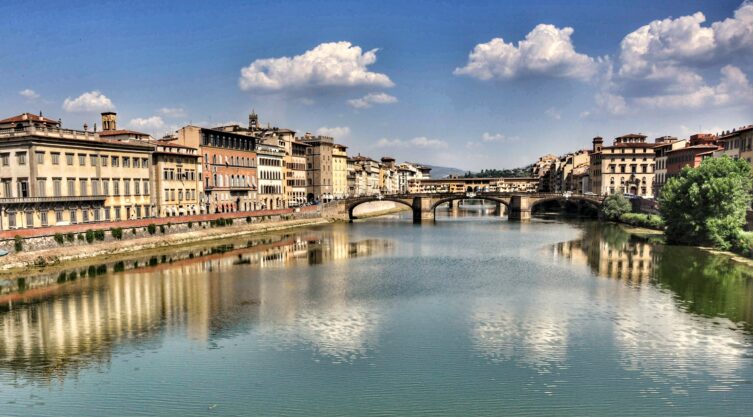
I marked this point of the trip only to encourage you to walk a short distance along the Arno River, towards the place where the Bridge of Vecchio looks great. In the evening, the view from this place becomes even more attractive because the setting sun beautifully illuminates the bridge and the city.
View from the bank of the Arno River to the Ponte Vecchio, GPS coordinates:
43°46’08.7″N 11°15’06.2″E
43.769074, 11.251710 - click and route
9. Pitti Palace
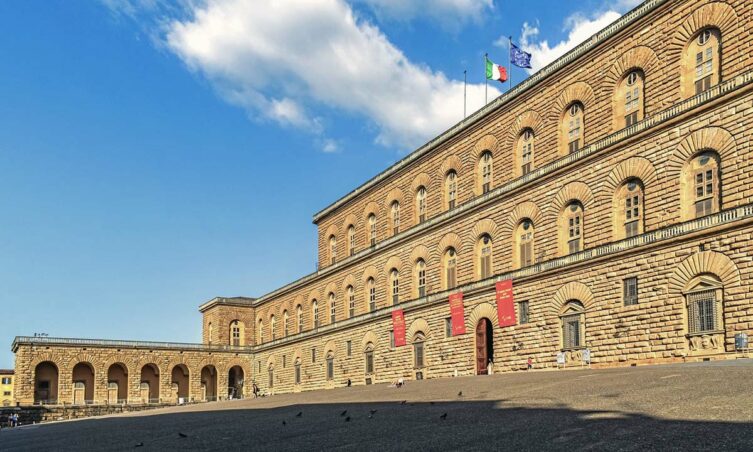
Palazzo Pitti, as its name rightly suggests, was not built by the Medici. It was built (though never completed) by Luca Pitti, the chief judge of Florence, a man of enormous influence and power, and a supporter and trusted man of Cosimo de' Medici (Cosimo di Giovanni de' Medici).
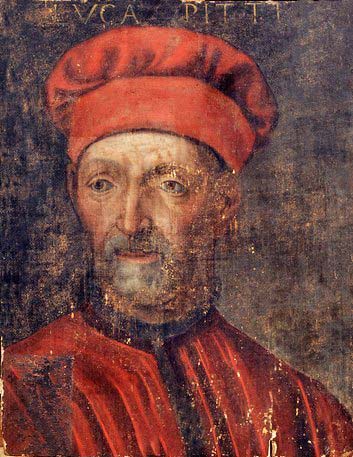
source Wikipedia under public domain rules
Luca Pitti was Kosma's trusted man so much that for several years, when Koma was unable to actually rule due to his health, Luca did it for him. Many historians claim that Pitti's enormous fortune was created largely due to the Medici's expressions of gratitude and the use of strong political influence. There is no evidence that would clearly confirm this is how Pitti achieved enormous wealth, but on the other hand, it is difficult to imagine that Pitti would not use his position to do so. The wealth that Pitti achieved prompted him to build a new palace. Pitti's ambitions were high and the building was supposed to outshine even the Medici palace with its size and beauty. Apparently, with complete discretion, Pitti ordered the designer to ensure that the windows in his palace were at least as large as the doors in the Medici palace. Interestingly, to this day it is not clear who was the designer employed by Pitti!!!
The death of Cosimo de' Medici (August 1, 1464), by a strange coincidence, caused Pitti to feel a severe lack of access to money and he quickly (1465) had to stop further construction of the palace, which he never completed. The building remained in this condition for the next 85 years. Only in 1550, another Medici (Cosimo I) bought the building from Pitti's heirs, completed it and established it as the main residence of the Medici, the rulers of the Grand Duchy of Tuscany.
Currently, Palazzo Pitti houses museums and is the largest museum complex in Florence. There are four objects inside:
– Galleria Palatina (paintings, including works by Raphael and Titian)
– Galleria d'Arte Moderna (Gallery of Contemporary Art)
– Museo degli Argenti (Museum of Silverware)
– Galleria del Costume (Costume Gallery)
Learn More: tickets to Palazzo Pitti – [click]
Palazzo Pitti, GPS coordinates:
43°45’54.9″N 11°15’00.1″E
43.765235, 11.250030 - click and route
9.1 Boboli Garden
The beautiful and extensive (11 hectares) Boboli Garden (inscribed on the UNESCO list) is adjacent to the Palazzo Pitti building. The garden was created on the orders of Cosimo I de' Medici for his wife Eleonora di Toledo. Here you will find ponds and richly decorated fountains, connected by walking paths. Due to its location (on a hill), the garden offers wonderful views of the Florence skyline.
I was tempted to write that the Boboli Garden is a good place to rest before continuing the walk, but the huge size of this facility makes you want to walk around it, so visiting here is more about further walking, not rest.
However, if you are looking for a place to relax, you will definitely find something for yourself in the garden.
The purchase of admission tickets to the Boboli Garden also entitles you to enter the Porcelain Museum (9.2) and the Bardini Garden (9.3), which is located on the way to Michelangelo's Square (10).
Check: entrance tickets to Boboli Garden – [click]
Boboli Garden, GPS coordinates:
43°45’49.3″N 11°15’04.7″E
43.763698, 11.251300 - click and route
9.2 Florence Porcelain Museum
The museum is located in one of the highest points of the Boboli Garden, in the so-called building. "knight's casino". The exhibition contains over 2000 exhibits of porcelain products donated to the rulers of Tuscany by other European rulers and purchased by them.
Porcelain Museum, GPS coordinates:
43°45’42.5″N 11°15’08.0″E
43.761810, 11.252214 - click and route
9.3 Bardinia's Garden and Villa
A garden located on a hillside with various plantings of flowers and the famous wisteria tunnel. However, before you go to see the beautiful flower tunnel, it is worth knowing that wisteria in Florence most often blooms from mid-April to early May. Apart from that, sometimes the tunnel doesn't make much of an impression.
In the garden there is a small terrace overlooking Florence and Villa Bardini, where the paintings of Pietro Annigoni are exhibited.
Bardini Garden – wisteria tunnel, GPS coordinates:
43°45’47.8″N 11°15’27.5″E
43.763281, 11.257628 - click and route
Villa Bardini, GPS coordinates:
43°45’50.5″N 11°15’22.4″E
43.764034, 11.256231 - click and route
10. Michelangelo Square with a panoramic view of Florence (Piazzale Michelangelo)
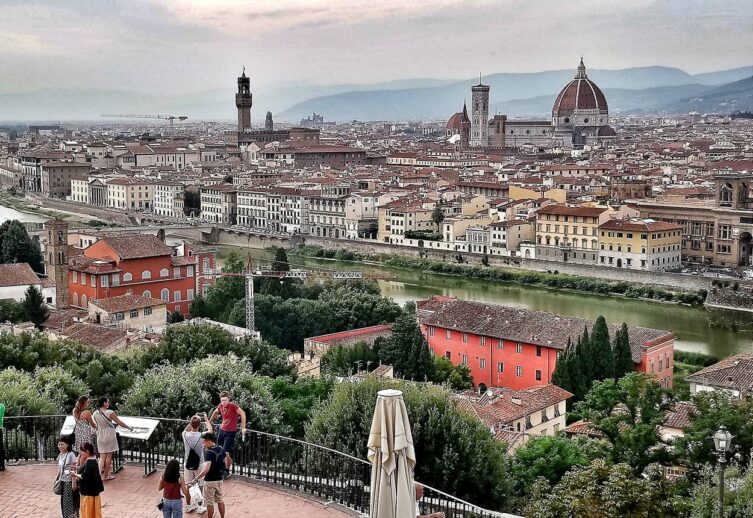
Piazza Michelangelo is the most important and famous viewing point in Florence. From this place, photos are taken showing the mighty cathedral of Santa Maria del Fiore surrounded by the rest of the city buildings. From here you can take a huge number of photos with close-ups of various parts of the city. You have all of Florence here at your fingertips, and if you've just had a walk through the city, you'll recognize all the places you've visited in an instant.
A stunning sight!
Michelangelo Square with a panorama of Florence, GPS coordinates:
43°45’54.9″N 11°15’00.1″E
43.765235, 11.250030 - click and route
11. Church of Santa Croce
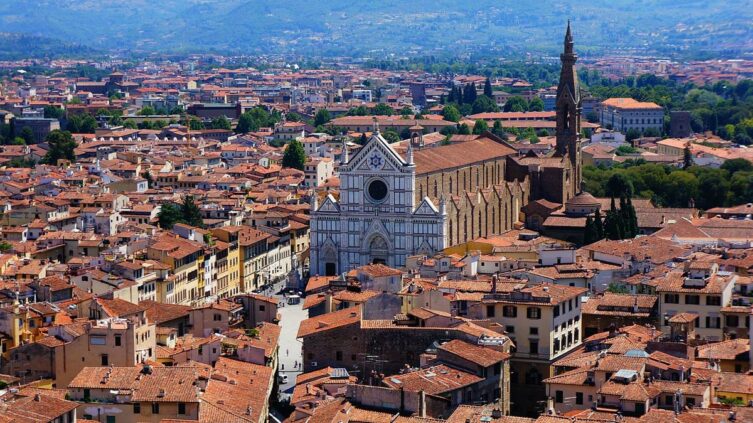
Over time, the Church of Santa Corce gained the name of the Pantheon. Over the centuries, it has become the resting place for many famous and important figures in the history of Florence, but also from outside it. The entire basilica is filled with tombs. On the church floor alone you will find 276 (!!!) marble tombstones, and on the walls there are impressive tombstones.
Santa Croce is now considered one of the most important churches in Italy. It is eagerly and increasingly visited by tourists who come to see, among others: graves of: Michelangelo, Galileo, Niccolò Machiavelli, Gioacchino Rossini (composer), Julia Clara-Bonaparte and Charlotte Bonaparte (wife and daughter of Napoleon Buonaparte).
Dante Alighieri also has his tombstone here, but his ashes are not there. Florence tried to bring them back, but Ravenna. where they are currently located refused to hand them over.
Several famous Poles are also buried in Santa Croce, including: Michał Ogiński (composer) and Aleksandra Moszczeńska (Juliusz Słowacki's beloved, who died at the age of 22).
Church of Santa Croce, GPS coordinates:
43°46’07.3″N 11°15’44.1″E
43.768700, 11.262261 - click and route
12. Vasari Corridor (Corridoio Vasariano)
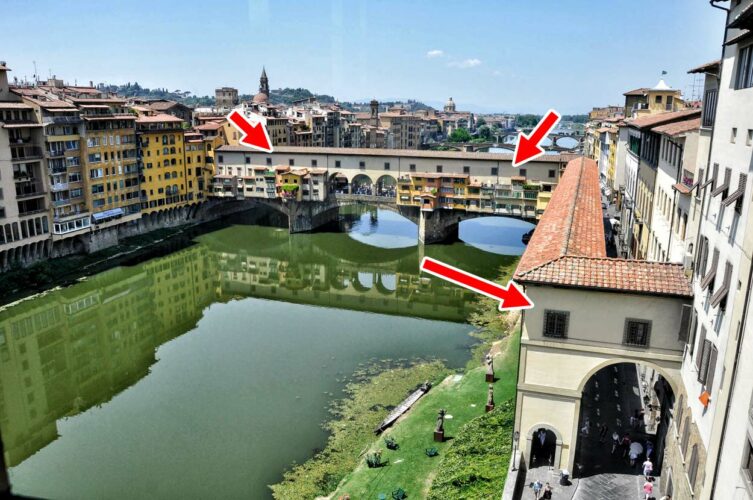
The Vasari Corridor is shrouded in many secrets. It often appears in literature as a secret passage, used to move unnoticed between the two banks of the Arno River. It was open to visitors for a short time, but for security reasons (its structure was severely damaged by a bomb attack in 1993).
When the Medici ruling Florence, or more precisely Cosimo I, bought their unfinished palace (Palazzo Pitti) from the Pitti family, he completed its construction and moved the main seat of the Medici family there. Over time, an idea emerged to create a safe and fast connection between the main center of power in Florence, Palazzo Vecchio, and Palazzo Pitti. The order for the design and implementation was given to the court architect of the Medici, Giorgio Vasari.
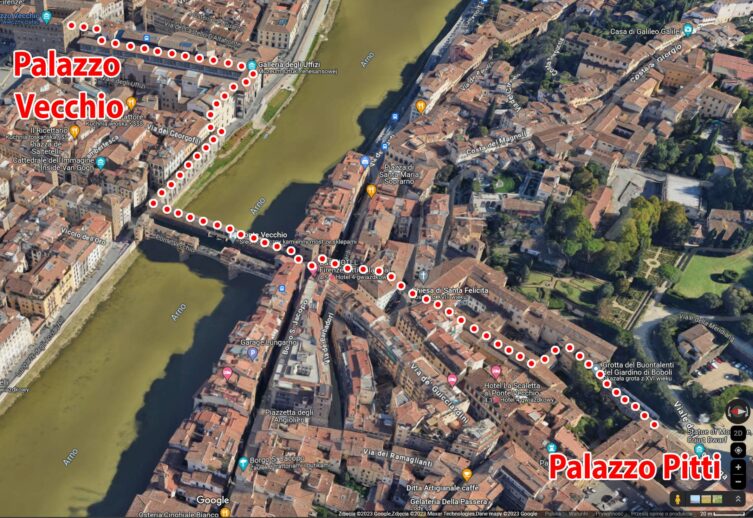
The corridor begins in the apartments of Eleonora di Toledo (wife of Cosimo I) on the second floor of the Palazzo Vecchio, runs over the roof of the church of San Pier Scheraggio and enters the top floor of the Uffizi Gallery, continuing along its corridors. On the opposite wall, the Uffizi is clearly visible because it is a structure supported by solid columns and runs along the Arno River to the Ponte Vecchio. The corridor passes through the Ponte Vecchio Bridge as a superstructure on the roofs of craft workshops, and on the other bank it strangely bypasses the Mannelli Tower, glued to its walls on brackets. The Manelli family did not agree to any modifications to the tower's structure, so Vasari had to bypass it when creating such a structure.
The course of the Vasari Corridor around the Mannelli Tower:
Next, the corridor crosses the arched structure of Via de Bardi and runs along the facade of the church of Santa Felicita, to which it has a special entrance to a separate, safe balcony inside, so as to ensure that the prince's family can participate in the mass without having to mix with the people. Then the corridor along Guicciardini Street runs behind the buildings towards the Boboli Gardens and, passing over the Buontalenti Grotto, enters the Pitti Palace through a narrow passage.
I included this description because the Vasari Corridor is undoubtedly a very interesting attraction of the city. Due to the fact that it is not open to the public, it can only be viewed from the outside. Quite coincidentally, its course coincides well with our plan to visit Florence. During the walk, looking for a corridor will make your sightseeing experience even more interesting. The photos below will certainly help a lot. I recommend! The game is really fun!
Florence – hotels and accommodation
If possible, it is worth spending the night in Florence. Like any city besieged by one-day tourists, Florence changes in the evening. However, it all depends on the size of your wallet. You can always look for something near the city and, having your own transport, stay in the city until late and then go to stay overnight outside Florence.
Below you will find some suggestions. Please do not use these as a specific indication of the hotels I recommend. Treat them as a good start for further exploration. The links I posted use the search engine mechanism, which, next to a specific hotel, always offers other, similar offers, often with more attractive prices. Additionally, the links contain filters I have prepared. They prevent the display of offers that could unnecessarily clutter search results and appropriately narrow the search area to the area that interests us. So you don't have to do it manually every time. I recommend using these links because they make your search easier and save time.
B&B La Nannina – [click]
Rebecca's house Florence – [click]
CASA IVH BNB – [click]
Important to me!
Give the article a good rating (5 stars welcome 😀)!It's free, a for me it is very important! The blog lives on visits and thus has a chance to develop. Please do it and ... thank you in advance!
If you like my guides, you will certainly find the one I created useful guide catalog - [click]. There you will find ready-made ideas for your next trips, descriptions of other tourist destinations and an alphabetical list of guides divided into countries, cities, islands and geographical regions.
I also post link to Facebook profile - [click]. Come in and press "Follow"then you will not miss new, inspiring posts.
Unless you prefer Instagram. I'm not a social media demon, but you can always count on something nice to look at on my instagram profile - [click]. The profile will gladly accept any follower who likes it.
I make the content I create available free of charge with copyright, and the blog survives from advertising and affiliate cooperation. So, automatic ads will be displayed in the content of the articles, and some links are affiliate links. This has no effect on the final price of the service or product, but I may earn a commission for displaying ads or following certain links. I only recommend services and products that I find good and helpful. Since the beginning of the blog's existence, I have not published any sponsored article.
Some of the readers who found the information here very helpful, sometimes ask me how you can support the blog? I do not run fundraisers or support programs (type: patronite, zrzutka or "buy coffee"). The best way is to use links. It costs you nothing, and support for the blog is self-generating.
Pozdrawiam


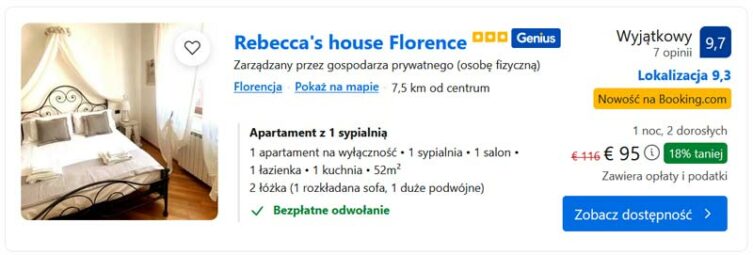
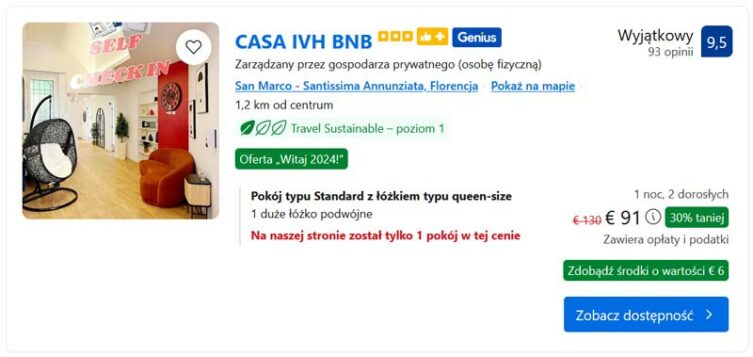
Thank you very much for your blog - it is an inspiration for me and another city visited thanks to your brilliant plan. I recommend it to all my friends.